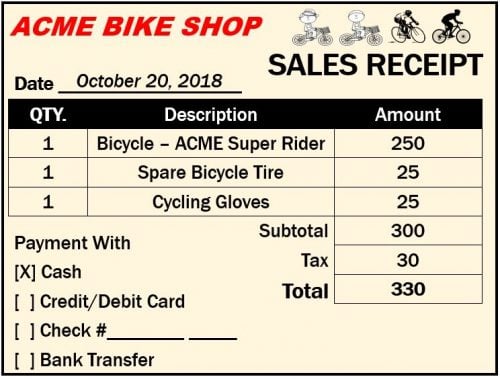A receipt is a piece of paper or electronic document confirming that the seller received money from the purchaser. The receipt typically includes the date and a description of the item the purchaser bought. It also includes a description of the item the buyer purchased.
When the transaction is between two businesses, receipts contain information about the method of payment and the buyer.
It is an acknowledgment from the vendor to the buyer that the vendor has received payment for a good or service. In this context, the word ‘good’ means ‘product.‘
As a verb, it means to mark something as paid, as in “here is the receipted hotel bill.”
Many kinds of payments
Individuals, companies, and other organizations may issue a receipt for many kinds of payments. They may issue a receipt, for example, for an online bank transfer, check (UK: cheque), or cash in hand. For the buyer, the receipt is proof of payment.
As far as the tax authorities are concerned, receipts require sellers to pay taxes on those sales.
In some countries, it is obligatory for the seller to provide a receipt to the buyer confirming transaction details. In most cases, the recipient of the money provides the receipt. However, sometimes the buyer generates one, as occurs when the buyer returns a product and requests a refund.

Wikipedia says the following regarding the term:
“To reduce the cost of postage and processing, many businesses do not mail receipts to customers, unless specifically requested or required by law, with some transmitting them electronically. Others, to reduce time and paper, may endorse an invoice, account or statement as ‘paid.'”
Receipt – act of receiving
The term may also refer to the state or act of receiving goods or money. If I say “We will deliver the goods on receipt of payment,” it means we will deliver the goods after we have received payment.
Receipt – income
Many businesses, such as theaters, use the term when referring to money received during a specific period. If I say “The theater’s receipts for the summer were 10% up on last year,” it means income was 10% higher.
Accounting – total money received
In accounting, the term means the total amount of money the government, business, or any organization has received.
If government income from alcohol tax rose by 10%, I could say “Alcohol tax receipts increased by 10% this year.”
Etymology of receipt
Etymology is the study of the origin of words, and also how their meanings have evolved.
According to etymonline.com, the term emerged in the late 14th century with the meaning ‘act of receiving.’ In the 14th century, it also meant ‘statement of ingredients in a medicine or potion.’ It came from the Old North French or Anglo-French word Receite, which meant ‘prescription, recipe, or receipt.’
The Anglo-French term came from the Old French word Recete, which came from the Latin word Recepta, meaning ‘received.’
It was not until c. 1600 that it also meant ‘written acknowledgment of good or money received.’
Receipt vs. invoice
Although invoices and receipts are sent by the same entity, i.e., the seller, their meanings are quite different.
An invoice is a request for payment by the seller. When sellers deliver goods to their customers, they also send invoices. An invoice, like the bill in a restaurant, is a request for payment. The seller sends the invoice before payment.
Put simply; an invoice is a ‘please pay me’ while a receipt is a ‘you have paid me’ document. If I want you to pay me, I send you an invoice stating how much you must pay and by when. When you have paid, I then give you a receipt, which states how much you paid and when.
Before payment, the vendor issues an invoice. After payment, the vendor issues a receipt.
